
FOLDING AND STORING
EXTENDING/RETRACTING THE CORD
When the volume of in-flight audio system is too loud
Turn on the volume limiter (volume attenuator) to reduce the volume.
Note
Sound distortion may occur and loud noise may be heard when the battery voltage is low.
This is not a malfunction. In this case, replace the battery with a new one.
Plug holder
Cord hole
STEREO HEADPHONES
CASQUE STEREO
AURICULARES ESTÉREO
HA-NC120 -J
© 2010 Victor Company of Japan, Limited
Printed in China
LNT0118-001A
BATTERY INSERTION
The battery should be changed when the operation indicator fades or does not turn on.
The noise-canceling function becomes less effective as the battery wears down so be sure to
replace the battery as necessary to maintain the proper performance of the headphones.
L
or
R
•
Be sure to insert the battery with the positive ª and negative · polarities correctly
positioned.
•
Do not heat, disassemble or short-circuit battery and never dispose of it by throwing it
in a fire.
•
Read the caution on the battery before use.
•
Be sure not to change the battery in a place where there is a lot of dust.
•
Be sure to remove the battery if you are not going to use the headphones for a long time.
Thank you for purchasing this JVC product.
Before you begin operating this unit, please read the operating instructions carefully to be sure you get the best possible performance.
If you have any questions, consult your JVC dealer.
English
SPECIFICATIONS
Frequency response 10 Hz – 21,000 Hz (power — ON)
Noise reduction
more than 18.5 dB at 200 Hz
*
Under the JVC measurement standard.
Sensitivity 113 dB/1 mW (power — ON)
114 dB/1 mW (power — OFF)
* Volume limiter — OFF
Input impedance 30 Ω (power — ON), 36 Ω (power — OFF)
*
Volume limiter — OFF
Driver unit ϕ30 mm
Power supply AAA battery (DC 1.5 V) x 1
Battery life Approx. 100 hours* (using Alkaline AAA battery)
Approx. 40 hours* (using Manganese AAA battery)
*
Varies depending on operating conditions.
*
Under the JVC measurement standard.
Cord length 0 – 1.2 m (3.94 ft)
Mass
160 g (5.64 oz) (incl. cord and battery)
145 g (5.11 oz) (excl. cord and battery)
Accessories Carrying pouch x 1
Manganese AAA battery (R03) x 1 (The supplied battery
is only for initial use.)
Dual plug adapter (for in-flight use) x 1
• Designs and specifications are subject to change without notice.
INSTRUCTIONS
MANUEL D’INSTRUCTIONS
MANUAL DE INSTRUCCIONES
Turn off the power before replacing the battery.
THE NOISE CANCELING FUNCTION
The active noise-canceling function does not reduce high frequency noise. It cancels
out noise which mainly consists of low frequencies, such as that from vehicles, air
conditioners, etc.
Notes
Operation indicator
Power switch
To activate the noise-canceling function
•
You can listen to an audio source even if you
do not turn on the headphones, but the noise-
canceling function will not work.
Misuse of the battery could result in leakage. This could cause a fire or an
explosion. To prevent this, pay special attention to the following points:
[European Union only]
[Union européenne uniquement]
[Sólo Unión Europea]
SPÉCIFICATIONS
Réponse en fréquence 10 Hz – 21.000 Hz (sous tension — ON)
Suppression de bruit
plus de 18,5 dB à 200 Hz
*
Sous le standard de mesure JVC.
Sensibilité 113 dB/1 mW (sous tension — ON)
114 dB/1 mW (hors tension — OFF)
* Limiteur de volume — OFF
Impédance d’entrée 30 Ω (sous tension — ON), 36 Ω (hors tension — OFF)
* Limiteur de volume — OFF
Écouteur ϕ30 mm
Alimentation Pile AAA (CC 1,5V) x 1
Durée de vie de la pile environ 100 heures* (pile alcaline AAA)
environ 40 heures* (pile manganèse AAA)
* Varie en fonction des conditions d’utilisation.
* Sous le standard de mesure JVC.
Longueur du cordon 0 – 1,2 m (3,94 pieds)
Poids
160 g (5,64 onces) (cordon et pile inclus)
145 g (5,11 onces) (sans le cordon et la pile)
Accessoires Housse de transport x 1
Pile manganèse AAA (R03) x 1
(La pile fournie est
uniquement pour l’utilisation initiale.)
Adaptateur de fiche double (pour utilisation dans les
avions) x 1
• Présentation et caractéristiques modifiables sans préavis.
Español
Français
ESPECIFICACIONES
Respuesta de frecuencia 10 Hz – 21.000 Hz (energía — ON)
Reducción de ruido
más de 18,5 dB a 200 Hz
*
De acuerdo con las normas de mediciónn de JVC.
Sensibilidad 113 dB/1 mW (energía — ON)
114 dB/1 mW (energía — OFF)
* Atenuador de volumen — OFF
Impedancia de entrada 30 Ω (energía — ON),
36 Ω (energía — OFF)
* Atenuador de volumen — OFF
Transductor ϕ30 mm
Alimentación una pila AAA (CC 1,5 V) x 1
Duración de la pila aprox. 100 horas* (con pila AAA alcalina)
aprox. 40 horas* (con pila AAA de manganeso)
* Varía según las condiciones de funcionamiento.
* De acuerdo con las normas de mediciónn de JVC.
Longitud del cable 0 – 1,2 m (3,94 pies)
Peso
160 g (5,64 onzas) (con el cable y la pila)
145 g (5,11 onzas) (sin el cable y la pila)
Accesorios
Estuche portátil x 1
Pila AAA de manganeso
(R03) x 1
(La pila suministrada
es sólo para uso inicial.)
Adaptador de enchufe doble (para uso durante el vuelo) x 1
• Diseño y especificaciones sujetos a modificaciones sin previo aviso.
English
Right housing
Volume limiter (volume attenuator) switch
(on the left housing)
CAUTION USING THE HEADPHONES
1. For your safety…
•
Never use the headphones when driving a car, motorcycle, or bicycle. This could result
in an accident.
•
Do not listen at high volume for an extended period. Do not use while driving or
cycling.
•
Pay special attention to traffic around you when using the headphones outside. Failure
to do so could result in an accident.
•
Be careful not to turn up the sound volume too high. Your hearing can be damaged by
listening to sounds at excessive volume for long periods.
•
Do not disassemble or modify the headphones.
•
Do not allow flammable, water or metallic objects to enter the headphones.
• If skin problems occur when in contact with headphones, discontinue use; otherwise it
may cause inflammation or irritation to the skin.
•
In the dry air such as in winter, you may feel a static shock when using the headphones.
•
If you feel sick while using the headphones, stop using immediately.
•
Be sure that your hair or any other objects do not get caught in the headband slider
(adjuster) when adjusting the headband.
2. Avoid using the headphones…
• in places subject to excessive humidity or dust
• in places subject to extremely high (over 40°C or 104°F) or low (under 0°C or 32°F)
temperatures
3. DO NOT leave the headphones…
• exposed to direct sunlight
• near a heater
4. To protect the headphones, DO NOT…
• allow them to get wet
• shake them or drop them against hard objects
5. Hearing Comfort and Well-being
• Do not play your personal audio at a high volume. Hearing experts advise against
continuous extended play.
• If you experience a ringing in your ears, reduce volume or discontinue use.
6. Traffic Safety
• Do not use while operating a motorized vehicle. It may create a traffic hazard and is
illegal in many areas.
• You should use extreme caution or temporarily discontinue use in potentially
hazardous situations.
• Even though your headphones are of the open-air type designed to let you hear outside
sounds, don’t turn up the volume so high that you can’t hear what’s around you.
☐ Be careful not to apply the power that exceeds the headphones’ input capacity. This may
result in sound distortion and could damage the oscillation board.
☐ Grasp and pull the plug itself to disconnect the headphones. Do not pull out the cord.
☐ When using the headphones nearby a cellular phone, noise may occur. Keep the
headphones away from the cellular phone.
☐ The ear pads will wear out earlier than the other parts even in normal use or in normal
storage due to the material characteristics.
☐ For replacement of the ear pads, consult with the dealer where you purchased the
headphones.
☐ When covering the headphones with an object, the noise-canceling function may not
work well or howling noise may occur. In this case, take away the object covering the
headphones.
☐ Please follow the instructions of the airlines when using the headphones in the aircraft
cabin. The headphones may not be usable depending on the audio system on the aircraft.
For Customer Use :
Enter the Model No. (on the inside of the
band) and the Serial No. (near the battery
housing) below.
Retain this information for future reference.
Model No.
Serial No.
To extend the cord
Pull out the cord gently to the desired length.
• The maximum cord length is 1.2 m (3.94 ft).
• When the end mark appears, stop pulling the cord to
prevent it from being damaged.
To retract the cord
Push the retract button using the projection on the back
of the plug.
• If the cord is not retracted, pull it out a little and try
again.
• You can retract the cord with a portable audio player
connected.
Notes
The cord retracts very quickly. Therefore, when
retracting the cord, hold it lightly near the cord hole to
make sure it retracts smoothly.
After retracting the cord, insert the plug into plug
holder.
• Do not insert the plug into the cord hole.
• Do not insert any other objects into the plug holder
or cord hole.
Retract button
End mark
1
Slide off the battery cover on the right
housing.
3
Close the battery cover.
2
Insert the · end first, then push the
battery in.
HA-NC120[J]-01.indd 1HA-NC120[J]-01.indd 1 10.6.16 2:57:58 PM10.6.16 2:57:58 PM


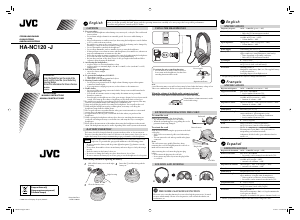

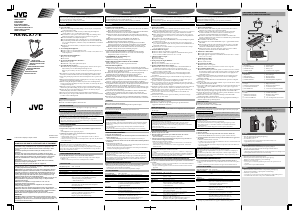
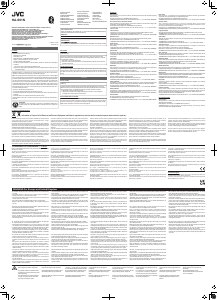
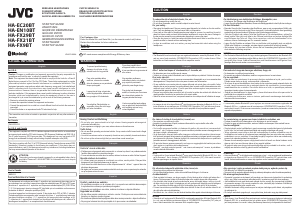
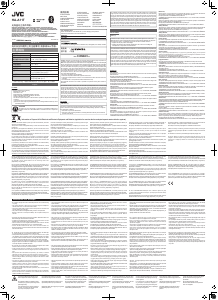

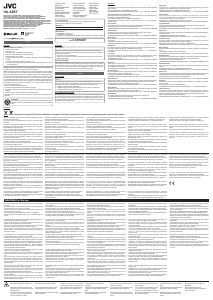
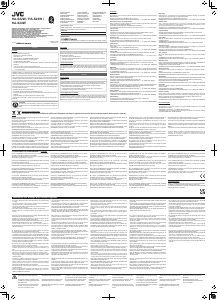
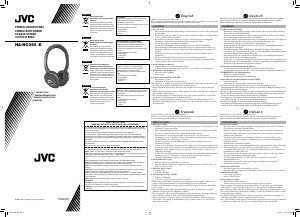
Joignez-vous à la conversation sur ce produit
Ici, vous pouvez partager ce que vous pensez du JVC HA-NC120-J Casque. Si vous avez une question, lisez d’abord attentivement le mode d’emploi. La demande d’un mode d’emploi peut être effectuée en utilisant notre formulaire de contact.
répondre | Cela a été utile (0)